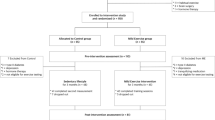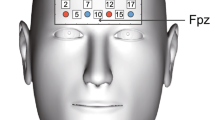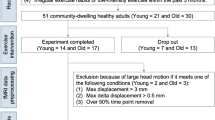Abstract
Exercise has a significant effect on maintaining the health of inhibitory function, a fundamental cognitive ability that supports daily mental processes. While previous studies have shown that a single bout of exercise, called acute exercise, could improve inhibitory control by stimulating the prefrontal cortex (PFC) and the arousal state, few studies have focused on the differences in the effects of exercise by age. In this study, young and older adults (mean age, 22.7 ± 1.4 and 68.7 ± 5.3 years, respectively) engaged in acute moderate-intensity exercise and inhibitory control. Before and at 5 and 30 min after exercise, the participants were asked to complete the reverse Stroop task, and their arousal state and PFC activity were measured using functional near-infrared spectroscopy. The findings showed that the overall inhibitory control improved immediately after performing acute exercise and remained improved even after 30 min. Particularly, there was a difference in the arousal state and middle PFC activity between the two age groups. Especially, the young adults showed an increase in the arousal state post-exercise, while the older adults tended to show an increase in the middle PFC activity. These results suggested that the acute exercise effects on the arousal state and PFC activity may vary depending on the developmental stage, but not for inhibitory control overtime. When these findings are considered, it is important to note that the exercise impact on cognitive control remained the same throughout the generations despite the observed changes in its impact on internal states.






Similar content being viewed by others
Availability of data and material
Available upon request.
Code availability
Available upon request.
References
Banich MT, Milham MP, Atchley R, Cohen NJ, Webb A, Wszalek T, Kramer AF, Liang ZP, Wright A, Shenker J, Magin R (2000) fMri studies of Stroop tasks reveal unique roles of anterior and posterior brain systems in attentional selection. J Cogn Neurosci 12:988–1000
Banich MT, Milham MP, Jacobson BL, Webb A, Wszalek T, Cohen NJ, Kramer AF (2001) Attentional selection and the processing of task-irrelevant information: insights from fMRI examinations of the Stroop task. Prog Brain Res 134:459–470
Baudic S, Tzortzis C, Dalla Barba G, Traykov L (2004) Executive deficits in elderly patients with major unipolar depression. J Geriatr Psychiatry Neurol 17:195–201
Blais C, Besner D (2006) Reverse Stroop effects with untranslated responses. J Exp Psychol Hum Percept Perform 32:1345–1353
Blais C, Besner D (2007) Reading aloud: when the effect of stimulus quality distinguishes between cascaded and thresholded components. Exp Psychol 54:215–224
Borg G (1998) Borg’s perceived exertion and pain scales. Human Kinetics, Illinois
Botvinick MM, Braver TS, Barch DM, Carter CS, Cohen JD (2001) Conflict monitoring and cognitive control. Psychol Rev 108:624–652
Bradley MM, Miccoli L, Escrig MA, Lang PJ (2008) The pupil as a measure of emotional arousal and automatic activation. Psychophysiology 45:602–607
Butters MA, Whyte EM, Nebes RD, Begley AE, Dew MA, Mulsant BH, Zmada MD, Bhalla R, Meltzer CC, Pollock BG, Reynolds CF, Becker JT (2004) The nature and determinants of neuropsychological functioning in late-life depression. Arch Gen Psychiatry 61:587–595
Byun K, Hyodo K, Suwabe K, Ochi G, Sakairi Y, Kato M, Dan I, Soya H (2014) Positive effect of acute mild exercise on executive function via arousal-related prefrontal activations: An fNIRS study. Neuroimage 98:336–345
Chang YK, Labban J, Gapin JI, Etnier J (2012) The effects of acute exercise on cognitive performance: a meta-analysis. Brain Res 1453:87–101
Chu CH, Kramer AF, Song TF, Wu CH, Hung TM, Chang YK (2017) Acute exercise and neurocognitive development in preadolescents and young adults: an ERP study. Neural Plast 2017:2631909
Comalli PE Jr, Wapner S, Werner H (1962) Interference effects of Stroop color-word test in childhood, adulthood, and aging. J Genet Psychol 100:47–53
Craig A (2002) How do you feel? Interoception: the sense of the physiological condition of the body. Nat Rev Neurosci 3:655–666
Critchley HD, Tang J, Glaser D, Butterworth B, Dolan RJ (2005) Anterior cingulate activity during error and autonomic response. Neuroimage 27:885–895
Del Giorno JM, Hall EE, O’Leary KC, Bixby WR, Miller PC (2010) Cognitive function during acute exercise: a test of the transient hypofrontality theory. J Sport Exerc Psychol 32:312–323
Demetriou EA, Lampit A, Quintana DS, Naismith SL, Song YJC, Pye JE, Hickie I, Guastella AJ (2018) Autism spectrum disorders: a meta-analysis of executive function. Mol Psychiatry 23:1198–1204
Dupuy FE, Clarke AR, Barry RJ, Selikowitz M, McCarthy R (2014) EEG and electrodermal activity in girls with attention-deficit/hyperactivity disorder. Clin Neurophysiol 125:491–499
Dupuy O, Gauthier CJ, Fraser SA, Desjardins-Crèpeau L, Desjardins M, Mekary S, Lesage F, Hoge RD, Pouliot P, Bherer L (2015) Higher levels of cardiovascular fitness are associated with better executive function and prefrontal oxygenation in younger and older women. Front Hum Neurosci 9:66
Ebbeling CB, Ward A, Puleo EM, Widrick J, Rippe JM (1991) Development of a single-stage submaximal treadmill walking test. Med Sci Sports Exerc 23:966–973
Faulkner J, Stoner L, Grigg R, Fryer S, Stone K, Lambrick D (2017) Acute effects of exercise posture on executive function in transient ischemic attack patients. Psychophysiology 54:1239–1248
Friedman NP, Miyake A (2004) The relations among inhibition and interference control functions: a latent-variable analysis. J Exp Psychol General 133:101–135
Hama H, Hashimoto E (1985) Change in conflict strength measured by color-word test in childhood, adulthood, and the aged. Shinrigaku Kenkyu 56:175–179
Hasher L, Zacks RT (1988) Working memory, comprehension, and aging: a review and a new view. Psychol Learn Motiv 22:193–225
Herold F, Wiegel P, Scholkmann F, Müller NG (2018) Applications of functional near-infrared spectroscopy (fNIRS) neuroimaging in exercise-cognition science: a systematic, methodology-focused review. J Clin Med 7:E466
Hillman CH, Pontifex MB, Raine LB, Castelli DM, Hall EE, Kramer AF (2009) The effect of acute treadmill walking on cognitive control and academic achievement in preadolescent children. Neuroscience 159:1044–1054
Hogan CL, Mata J, Carstensen LL (2013) Exercise holds immediate benefits for affect and cognition in younger and older adults. Psychol Aging 28:587–594
Hoshi Y, Kobayashi N, Tamura M (2001) Interpretation of near-infrared spectroscopy signals: a study with a newly developed perfused rat brain model. J Appl Physiol 90:1657–1662
Humphreys MS, Revelle W (1984) Personality, motivation, and performance: a theory of the relationship between individual differences and information processing. Psychol Rev 91:153–184
Hyodo K, Dan I, Suwabe K, Kyutoku Y, Yamada Y, Akahori M, Byun K, Kato M, Soya H (2012) Acute moderate exercise enhances compensatory brain activation in older adults. Neurobiol Aging 33:2621–2632
Hyodo K, Suwabe K, Soya H, Nagamatsu T (2017) The effect of an acute bout of slow aerobic dance on mood and executive function in older adults: a pilot study. Bull Phys Fitness Res Inst 115:35–41
Joyce J, Graydon J, McMorris T, Davranche K (2009) The time course effect of moderate intensity exercise on response execution and response inhibition. Brain Cogn 71:14–19
Kamijo K, Hayashi Y, Sakai T, Yahiro T, Tanaka K, Nishihira Y (2009) Acute effects of aerobic exercise on cognitive function in older adults. J Gerontol B Psychol Sci Soc Sci 64B:356–363
Karvonen MJ, Kentala E, Mustala O (1957) The effects of training on heart rate: a longitudinal study. Ann Med Exp Biol Fenn 35:307–315
Khalsa SS, Lapidus RC (2016) Can Interoception improve the pragmatic search for biomarkers in psychiatry? Front Psychiatry 7:121
Kimura A, Okada K, Sato A, Suzuki H (1994) Regional cerebral blood flow in the frontal, parietal and occipital cortices increases independently of systemic arterial pressure during slow walking in conscious rats. Neurosci Res 20:309–315
Kita Y, Gunji A, Inoue Y, Goto T, Sakihara K, Kaga M, Inagaki M, Hosokawa T (2011) Self-face recognition in children with autism spectrum disorders: a near-infrared spectroscopy study. Brain Dev 33:494–503
Kurosawa M, Okada K, Sato A, Uchida S (1993) Extracellular release of acetylcholine, noradrenaline and serotonin increases in the cerebral cortex during walking in conscious rats. Neurosci Lett 161:73–76
American College of Sports Medicine (2014) ACSM’s guidelines for exercise testing and prescription, 9th edn. Lippincott Williams & Wilkins, Baltimore. http://antoinedl.com/fichiers/public/ACSM-guidelines-2014.pdf. Accessed 26 Mar 2020
Lowenstein O, Feinberg R, Loewenfeld IE (1963) Pupillary movements during acute and chronic fatigue. Invest Ophthalmol Vis Sci 2:138–157
MacLeod CM (1991) Half a century of research on the Stroop effect: an integrative review. Psychol Bull 109:163–203
Matsuda G, Hiraki K (2006) Sustained decrease in oxygenated hemoglobin during video games in the dorsal prefrontal cortex: a NIRS study of children. Neuroimage 29:706–711
Matsuda K, Ikeda S, Mitsutake T, Nakahara M, Nagai Y, Ikeda T, Horikawa E (2017) Factors influencing executive function by physical activity level among young adults: a near-infrared spectroscopy study. J Phys Ther Sci 29:470–475
Matsumoto A, Hakoda Y, Watanabe M (2012) Life-span development of Stroop and reverse-Stroop interference measured using matching responses. Shinrigaku Kenkyu 83:337–346
Mead LA, Mayer AR, Bobholz JA, Woodley SJ, Cunningham JM, Hammeke TA, Rao SM (2002) Neural basis of the Stroop interference task: response competition or selective attention? J Int Neuropsychol Soc 8:735–742
Milham MP, Erickson KI, Banich MT, Kramer AF, Webb A, Wszalek T, Cohen NJ (2002) Attentional control in the aging brain: insights from an fMRI study of the Stroop task. Brain Cogn 49:277–296
Miyake A, Friedman NP, Emerson MJ, Witzki AH, Howerter A, Wager TD (2000) The unity and diversity of executive functions and their contributions to complex “frontal lobe” tasks: a latent variable analysis. Cogn Psychol 41:49–100
Moriguchi Y, Hiraki K (2009) Neural origin of cognitive shifting in young children. Proc Natl Acad Sci USA 106:6017–6021
Murata Y, Watanabe T, Terasawa S, Nakajima K, Kobayashi T, Yong Z, Okuhara M, Nakade K, Terasawa K, Maruo SK (2015) Moderate exercise improves cognitive performance and decreases cortical activation in the go/no-go task. BAOJ Med Nurs 1:002
Nemeth BA, Carrel AL, Eickhoff J, Clark RR, Peterson SE, Allen DB (2009) Submaximal treadmill test predicts VO2max in overweight children. J Pediatr 154:677–681
Netz Y, Abu-Rukun M, Tsuk S, Dwolatzky T, Carasso R, Levin O, Dunsky A (2016) Acute aerobic activity enhances response inhibition for less than 30 min. Brain Cogn 109:59–65
Nguyen-Tri D, Overbury O, Faubert J (2003) The role of lenticular senescence in age-related color vision changes. Invest Ophthalmol Vis Sci 44:3698–3704
Noonan V, Dean E (2000) Submaximal exercise testing: clinical application and interpretation. Phys Ther 80:782–807
Pardo JV, Pardo PJ, Janer KW, Raichle ME (1990) The anterior cingulate cortex mediates processing selection in the Stroop attentional conflict paradigm. Proc Natl Acad Sci USA 87:256–259
Physical Activity Guidelines Advisory Committee (2008) Physical activity guidelines advisory committee report. U.S. Department of Health and Human Services, Washington, DC
Pokorny J, Smith VC, Lutze M (1987) Aging of the human lens. Appl Opt 26:1437–1440
Pontifex MB, Hillman CH, Fernhall B, Thompson KM, Valentini TA (2009) The effect of acute aerobic and resistance exercise on working memory. Med Sci Sports Exerc 41:927–934
Raven JC, Court JH, Raven J (1976) Manual for Raven’s coloured progressive matrices. H K Lewis, London
Robbins TW (1997) Arousal systems and attentional processes. Biol Psychol 45:57–71
Rushworth MFS, Walton ME, Kennerley SW, Bannerman DM (2004) Action sets and decisions in the medial frontal cortex. Trends Cogn Sci 8:410–417
Sakairi Y, Nakatsuka K, Shimizu T (2013) Development of the two-dimensional mood scale for self-monitoring and self-regulation of momentary mood states. Jpn Psychol Res 55:338–349
Schweitzer I, Tuckwell V, O’Brien J, Ames D (2002) Is late onset depression a prodrome to dementia? Int J Geriatr Psychiatry 17:997–1005
Sheline YI, Barch DM, Garcia K, Gersing K, Pieper C, Welsh-Bohmer K, Steffens DC, Doraiswamy PM (2006) Cognitive function in late life depression: relationships to depression severity, cerebrovascular risk factors and processing speed. Biol Psychiatry 60:58–65
Shimada S, Hiraki K (2006) Infant’s brain responses to live and televised action. Neuroimage 32:930–939
Strangman G, Culver JP, Thompson JH, Boas DA (2002) A quantitative comparison of simultaneous BOLD fMRI and NIRS recordings during functional brain activation. Neuroimage 17:719–731
Stroop JR (1935) Studies of interference in serial verbal reactions. J Exp Psychol 18:643–662
Sudo M, Komiyama T, Aoyagi R, Nagamatsu T, Higaki Y, Ando S (2017) Executive function after exhaustive exercise. Eur J Appl Physiol 117:2029–2038
Tang SW, Chu E, Hui T, Helmeste D, Law C (2008) Influence of exercise on serum brain-derived neurotrophic factor concentrations in healthy human subjects. Neurosci Lett 431:65–65
Terasawa Y, Fukushima H, Umeda S (2013) How does interoceptive awareness interact with the subjective experience of emotion? An fMRI study. Hum Brain Mapp 34:598–612
Tomporowski PD, Ganio MS (2006) Short-term effects of aerobic exercise on executive processing, memory, and emotional reactivity. Int J Sport Exerc Psychol 4:57–72
Tsujii T, Komatsu K, Sakatani K (2013) Acute effects of physical exercise on prefrontal cortex activity in older adults: a functional near-infrared spectroscopy study. Adv Exp Med Biol 765:293–298
Villringer A, Chance B (1997) Non-invasive optical spectroscopy and imaging of human brain function. Trends Neurosci 20:435–442
Waddoups L, Wagner D, Fallon J, Heath E (2008) Validation of a single-stage submaximal treadmill walking test. J Sports Sci 26:491–497
Wang W, Qiu C, Ota T, Sawada M, Kishimoto N, Kishimoto T (2013) Effects of Tai-Chi exercise on attention in healthy elderly subjects as measured by near-infrared spectroscopy during the Stroop task. J Nara Med Assoc 64:79–86
World Health Organization (2010) Global recommendations on physical activity for health. WHO Press, Switzerland. https://www.who.int/dietphysicalactivity/global-PA-recs-2010.pdf. Accessed 15 Apr 2020
Wyczesany M, Kaiser J, Coenen AML (2008) Subjective mood estimation co-varies with spectral power EEG characteristics. Acta Neurobiol Exp (Wars) 68:180–192
Yamagata S, Takahashi Y, Shigemasu K, Ono Y, Kijima N (2005) Development and validation of Japanese version of effortful control scale for adults. Jap J Pers 14:30–41
Yamazaki Y, Sato D, Yamashiro K, Tsubaki A, Yamaguchi Y, Takehara N, Maruyama A (2017) Inter-individual differences in exercise-induced spatial working memory improvement: a near infra-red spectroscopy study. Adv Exp Med Biol 977:81–88
Yanagisawa H, Dan I, Tsuzuki D, Kato M, Okamoto M, Kyutoku Y, Soya H (2010) Acute moderate exercise elicits increased dorsolateral prefrontal activation and improves cognitive performance with Stroop test. Neuroimage 50:1702–1710
Yasumura A, Kokubo N, Yamamoto H, Yasumura Y, Nakagawa E, Kaga M, Hiraki K, Inagaki M (2014) Neurobehavioral and hemodynamic evaluation of Stroop and reverse Stroop interference in children with attention-deficit/hyperactivity disorder. Brain Dev 36:97–106
Yasumura A, Omori M, Fukuda A, Takahashi J, Yasumura Y, Nakagawa E, Koike T, Yamashita Y, Miyajima T, Koeda T, Aihara M, Inagaki M (2019) Age-related differences in frontal lobe function in children with ADHD. Brain Dev 41:577–586
Zillmann D (1979) Hostility and aggression. Wiley, New York
Acknowledgements
The authors would like to thank the staff members of Higashi Clinic and h3 Support in Tamana city, Japan, for their support during our research, when the main results of this paper were obtained. We also thank Editage (https://www.editage.com) for English editing. This work was supported by the Japan Society for the Promotion of Science KAKENHI Grants 19K14300 and 19H00631 to AY and WT, respectively.
Funding
This work was supported by the Japan Society for the Promotion of Science KAKENHI Grants 19K14300 and 19H00631 to AY and WT, respectively.
Author information
Authors and Affiliations
Contributions
HF analyzed and corrected the participants’ data regarding behavioral and neural indices, and was a major contributor in writing the manuscript. AM and AY corrected and analyzed the data on the participants’ medical history and organized the experiments. All authors read and approved the final manuscript.
Corresponding author
Ethics declarations
Conflict of interest
There are no conflicts of interest to disclose.
Ethics approval
The Ethics Committee of the Graduate School of Social and Cultural Sciences of Kumamoto University approved this study (Approval number: 45, 2020).
Consent to participate
Written informed consent to participate was obtained from all participants.
Consent for publication
Not applicable.
Additional information
Communicated by Winston D. Byblow.
Publisher's Note
Springer Nature remains neutral with regard to jurisdictional claims in published maps and institutional affiliations.
Rights and permissions
About this article
Cite this article
Fujihara, H., Megumi, A. & Yasumura, A. The acute effect of moderate-intensity exercise on inhibitory control and activation of prefrontal cortex in younger and older adults. Exp Brain Res 239, 1765–1778 (2021). https://doi.org/10.1007/s00221-021-06086-9
Received:
Accepted:
Published:
Issue Date:
DOI: https://doi.org/10.1007/s00221-021-06086-9




